AirTags Are the Perfectly Boring, Functional Future of AR
Apple’s new location-aware widgets point to the company’s possible larger ambitions for augmented reality….

Many iPhone owners have already used AR on their Apple handset, even if they haven’t realized it. One of the most useful AR tools built into the iPhone is its simplest, the virtual tape measure in the Measure app—helpful for when you want to figure out how wide your new bed is or what size frame you need to hang that photo on the wall. And five years ago Niantic Labs’ Pokémon Go became a viral AR sensation, with millions of people experiencing the physical world through their phone screens as they hunted virtual game characters.
AirTags can be personalized with messages or emoji.
Photograph: AppleThe difference with AR games like Pokémon Go, Wetzstein says, is they are still primarily reliant on the phone’s Wi-Fi and GPS radios to determine location, sensors which cannot provide nearly as precise location information as the ultra-wideband tech. Something low-cost and low-power like the AirTag, Wetzstein says, seems like “the perfect choice” for enabling apps that depend on more precise tracking.
Jessica Brillhart, who runs the mixed reality lab at USC’s Institute for Creative Technologies, points out that location tags could also be a way of sharing two-way information about objects within a space. Attach one of these tags to an object, assign it a name, and “the system can learn at scale what constitutes a fridge, what constitutes a bridge, what constitutes a tree,” Brillhart says. “So it’s an access point, but it works in tandem, feeding information to the system and helping people contextualize the world.”
It’s worth noting that Apple hasn’t identified this as a specific use case for AirTags, but the fact cannot be ignored that once a network of location-aware devices exists in the world, that network could provide the knowledge necessary to unlock more powerful applications.
“The biggest hurdle in AR is really knowing what it is you’re looking at or knowing where you are, but these AirTags may help contribute to that understanding,” Brillhart says.
Apple has not yet responded to requests for comment on this story. But Apple’s AR ambitions likely don’t end with AirTags, the Measure app, and flashy games. The company is reportedly working on AR glasses—as are Facebook, Snap, and others—though more recent reports suggest Apple’s first heads-up display may be more of a niche device than a consumer-friendly product.
But even if those Apple AR glasses arrive and become a success, and even if more AR games like Pokémon Go emerge to steal the hearts of children and adults, iPhone owners will continue to experience AR in more mundane, but ultimately more useful, ways. Whether they’re using their iPhone to measure a filing cabinet for their home office, or following onscreen arrows to find their AirTagged backpack before rushing off to school, they’re plugged into Apple’s vision of augmented reality. No glasses required.
More Great WIRED Stories
- 📩 The latest on tech, science, and more: Get our newsletters!
- Here’s what it takes to fly a drone on Mount Everest
- AI comes to car repair, and body shop owners aren’t happy
- 7 emergency preparedness apps to keep on your phone
- Bill Gates is upbeat on climate, capitalism, and even politics
- How to stop misinformation before it gets shared
- 👁️ Explore AI like never before with our new database
- 🎮 WIRED Games: Get the latest tips, reviews, and more
- 💻 Upgrade your work game with our Gear team’s favorite laptops, keyboards, typing alternatives, and noise-canceling headphones





